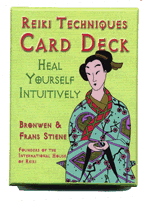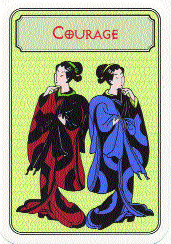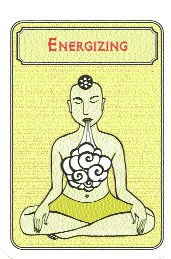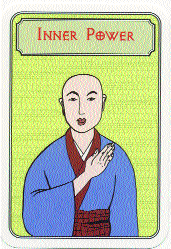Positive Health Online
Your Country

The Power of Reiki Techniques
by Frans and Bronwen Stiene(more info)
listed in reiki, originally published in issue 128 - October 2006
Reiki
A spiritual healing practice from Japan, the system of Reiki uses energy to clear energy paths and promote healing on physical, psychological, emotional and spiritual levels. Reiki techniques are one of the major elements of this system, and practising them supports great inner change.
Technique Origins
The first Reiki techniques were introduced in the early 1900s in Japan. They aimed at building energy in the body and strengthening one's spiritual connection. These aims also lay at the foundation of many newly introduced Reiki techniques.
Old and New Energetic Foundations
In moving Reiki (literally translated as 'spiritual energy') in the body, the energy must travel through energetic channels. Today, two unique energetic methods are at the base of the system of Reiki and its techniques. One is from Japan, while the other is a recent addition from the West.
The first is the traditional Japanese energetic method called the hara system. It focuses largely on building and strengthening one's energy, beginning in the abdomen area. This area of the body grounds and strengthens you. Without this strong foundation behind a personal practice, it is believed that the practice will not have the opportunity to blossom into its full potential.
Over the last 20 years, a multitude of New Age techniques, based on the second energetic method – the chakra system, have been adapted and included into the system of Reiki. These techniques might range from Native American Indian practices through to Tibetan Buddhist meditations.
Choosing a Technique
With the abundance of techniques taught within the system of Reiki today, you may wonder which technique is best suited to you? This will depend upon a number of variables:
• The specific branch of Reiki you study or are interested in. Its focus will determine the style of techniques taught, e.g. Japanese, Tibetan, Indian, etc;
• Your teacher may guide you with the choice of technique that is relevant to your personal level of accomplishment within the system;
• The specific outcomes that you wish to work toward. Many techniques are specialized, supporting certain areas of your life in creating change;
• Your intuitive sense as to which technique is appropriate at a particular moment in your life.
Preparing to Practise
Preparation is important for any technique.
First find yourself a place to practise, one that is relatively quiet and where you will not be disturbed. However, no matter where you find yourself there will always be sound – this is a natural part of life. Do not attach to the sounds that you can hear – let them float in and then out again.
It can be beneficial to practise your technique in the same physical space, such as in a comfortable corner of the bedroom or under a particular tree. This creates a ritual that helps draw you more rapidly into the depths of the technique.
Know the technique you are about to embark on. Hold a clear understanding of the physical and mental expectations of your technique. Interestingly, some practitioners begin to feel the energetic effects of a technique even during their preparation. This indicates the practitioner's strong sense of focus, and supports us in the understanding that there is more to a technique than the simple reproduction of a physical ritual.
A Key to Making Your Technique Work
The set purpose you hold in your mind when you begin a technique is called your intent. Your intent is what will have the greatest effect on the outcome of your practice.
Interestingly, there is only one clear intent that you need hold in your mind when approaching a technique. This particular intent never alters no matter what the aim of an individual technique might be. By approaching each technique with this same intent you will gain more than you could have possibly thought imaginable from your technique.
So what should your intent be? Intend to become the technique itself.
When you hold the intent to become the technique you are practising, you have already set yourself up for success.
Working the Technique
Each technique has many layers. It is imperative that you discover each of these layers within the technique; experience each new understanding fully as it arises, before moving to the next level.
At times in your practice you may feel that you have gained a complete understanding of the technique, but take it a step further, push it and find out if that is really the truth.
In a broad sense, all techniques have been created to facilitate change. When we begin a technique we start to sporadically enjoy the benefits of making a connection to the technique – this may be experienced as brief moments of calm, relaxation or peacefulness. The excitement and relief that you might feel at sensing this connection can be like hitting the jackpot. "I'm there!" Well, hang on a moment, what happens when you trip over the cat and land in a puddle – do you swear at the cat? If so, you've some way to go yet. Change is not complete.
It may not be complete, but you now have a handle to hold onto. That sense of connection is something that will grow with more practice. Consciousness of that connection will begin to seep into your daily life until your reactions come into alignment with the aims of your technique.
The Necessity of a Teacher
A teacher can help you to discover the reality of your situation when practising. Ideally, a teacher is someone who has already moved through the layers and is, therefore, totally aware of where your experience sits within the multi-dimensions that exist inside the shell that is your technique.
It is, however, not always possible to find a teacher who lives up to these expectations. Keep this in mind, as sometimes it is necessary to work alone rather than with an unsuitable teacher. Some teachers can be more of a setback than a support.
Apart from a teacher's duty to be highly educated in the teachings, the teacher's job is also to push you and stretch you while always remaining respectful of you.
Removing the Technique
Once you have become the technique it is possible for you to remove its actual physical structure. Now you can summon up the technique energetically without having to use a physical ritual or systematic procedure to 'call' the technique in. Your strength of connection to the technique is immediate, and your absolute knowledge of it is pure.
Removing the physical structure of the technique prior to having achieved this perfected understanding of your technique will result in an inability to achieve the technique's aim.
Avoiding Pitfalls
With a conscious awareness of what you are doing and why, you will have the clarity to avoid the pitfalls that can waylay practitioners.
Phenomena can occur when practising techniques. You might feel, see, sense, or even hear things. These phenomena offer you one of the greatest obstacles to your practice. You can become so involved in interpreting, or attempting to repeat these unusual experiences, that the aim of your technique is forgotten. Phenomena exist to assure us that we are working through the layers of our practice, but do not get distracted – they are not the practice itself.
The inability to create a daily routine is another obstacle along the practitioner's chosen path of self-development. Consider this prior to beginning a technique, and set yourself short- and long-term goals. For example, 'Although my long-term aim is to practise this technique until I am ready to move on to a new one, my short-term goal is that I practise every night for 15 minutes for a week.'
Keep creating short-term goals, and eventually you will find that you have been effective in achieving your long-term goal.
Achieving Success
A successful personal practice awaits you. Here are a number of hints that can further support you with this.
Do not doubt, there will be success as a result of working with the technique. Belief in yourself, the technique and, if you have one, your teacher, are elements that ensure a smooth practice.
Respect your practice. What does this mean? It means that you practise in accordance with the instructions provided, rather than taking the stance that you automatically know better, and then whimsically begin to alter it.
And lastly, persevere. Stick with it. The results of your efforts will enable you to encourage and inspire not only yourself, but everyone you meet, and everything you touch.

Books
Stiene B and Stiene F. The Reiki Sourcebook. O Books. Winchester. UK. ISBN 1-903816-55-6. 2003.
Stiene B and Stiene F. The Japanese Art of Reiki. O Books. Winchester. UK. ISBN 1-905047-02-9. 2005.
Stiene B and Stiene F. Reiki Techniques Card Deck. O Books. Winchester. UK. ISBN 1-905-047-19-3. 2006.
Stiene B and Stiene F. A-Z of Reiki. O Books. Winchester. UK. ISBN 1-905-047-89-4. 2006.
Bibliography
Davey HE. Living the Japanese Arts and Ways. Stonebridge Press. Berkeley. 2003.
Doi Hiroshi. Modern Reiki Method for Healing. Fraser Journal Publishing. British Columbia. 2000.
Eguchi Toshihiro. Te no Hira Ryôji Nyûmon. Arusu Publishing. Japan. 1930.
Reed William. Ki – A Practical Guide for Westerners. Japan Publications Inc. Tôkyô. 1986.
Reiki Ryôhô Hikkei. Usui Reiki Ryôho Gakkai. Japan.
Comments:
-
No Article Comments available


